"We will break the gap, the rest will be by itself"
Entente plans
Russia's withdrawal from the war and the systematic transfer of German troops from the Eastern Front to the Western Front, which began after this, did not leave the general staffs of Britain and France doubt that in the near future Germany would strike a powerful blow at the Western European theater of operations. It was obvious that the German bloc was not able to continue the positional war of attrition, and would try to snatch victory in a decisive offensive.
Already 26 in July 1917 at the inter-union conference in Paris, the leaders of the Allied armies, Generals F. Foch, A. Petain, D. Pershing, L. Cadorna and V. Robertson, compiled a coordinated report entitled “What to do if Russia leaves the war”. The report noted that even if the German command transferred the forces that acted against Russia to the French front, the allies would still be able to hold out until the arrival of the American divisions. At the heart of the Allied plan were the following conditions: 1) transition to defense on all secondary fronts and the transfer of troops from there to France and Belgium; 2) the maximum acceleration of the transportation of the American army in Western Europe; 3) single command on the Western Front.
In November, the command of the French army considered 1917 that, after the cessation of hostilities against Russia, 40-50 of the German divisions and around 20 of the Austro-Hungarian divisions could be deployed to the Western Front. At the same time Austria-Hungary could concentrate all forces only against Italy. It was assumed that the number of German divisions on the Western Front will increase to 200. Allies will be able to counter them no more than 170 divisions. In such a situation, the commander-in-chief of the French army, General Petain, noted in a report to the Military Committee of November 18 1917, “the situation dictates to the Entente wait-and-see tactics” on the Western front. This tactic, he continued, "demanded the organization of the front as much as possible, the creation of numerous reserves and the cooperation of the allied armies ...".
Already in the autumn of 1917, when the Austro-German troops inflicted a heavy defeat on the Italian army at Caporetto, the heads of the allied governments came to the decision to form the Supreme Military Council to improve the coordination of operations in the Western European theater. The Council consisted of heads of government and representatives of the general staffs of England, France, Italy and the United States. As military representatives, the council included: from France - M. Weygand, from England - G. Wilson, from Italy - L. Cadorna, from the USA - T. Bliss.
The formation of the Supreme Military Council has not yet solved the problem of creating a unified command. The British were strongly opposed to such a decision. In December, 1917, the British Prime Minister, Lloyd George, told the House of Commons: “I am strongly opposed to this institution. It could not work; it would lead not only to misunderstandings between armies, but also to disagreement between countries and governments. ” This point was maintained by the British command and was also divided by the French commander Petain. The British and the French did not want to obey each other. These differences seriously hampered the development of an overall strategic plan for the 1918 campaign of the year.
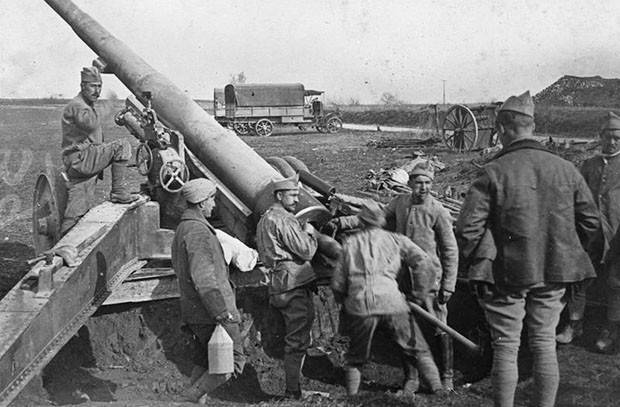
French gunners during the Spring Offensive
January 30 in Versailles opened the meeting of the Supreme Military Council of the Entente. Four draft plans for the upcoming campaign were submitted for its consideration. The first to offer his project was the head of the French General Staff, F. Foch. He noted that in the 1918 year we should expect a strong German offensive. "It will be combined in space and in time, that is, distributed over different parts of the French-English front, and maybe the Italian front at different time intervals." Foch believed that the measures being carried out by the French and British command would allow the enemy’s offensive to be delayed and the Germans would not achieve a decisive result. However, it is necessary not only to passively defend ourselves, but to use the opportune moment to seize a strategic initiative, and to go over to the counter offensive. To do this, the Allied armies must “in the event of an offensive of the enemy not only delay and counter-attack him in the area of his offensive, but also undertake powerful counterattacks with the aim of diverting the enemy in the previously selected sectors prepared for the rapid conduct of such operations.” It is necessary to strive to “give these operations the form of a combined attack with decisive goals.”
Foch's proposal, the most sensible in the current situation, met with decisive resistance from the commanders-in-chief of the British and French armies. Petain and Haig put forward their previously agreed draft. They believed that, in view of the numerical superiority of the enemy, the Allies on the Western Front should confine themselves only to defense. The allied armies during the 1918 campaign of the year, in their opinion, will not be able, until the American army is fully concentrated, to launch counter-attacks, much less go on to a decisive offensive.
The third project was proposed by Lloyd George. Supporting Haig and Petain in the necessity of defensive actions in France, he noted that since in the near future it is impossible to achieve a decisive victory on the Western Front, it is necessary to strike the main blow in Palestine. To inflict a decisive defeat of the Ottoman Empire and bring it out of the war. Against this idea, the head of government and at the same time the Minister of War of France Georges Clemenceau joined. He noted that this operation would be a “purely British affair,” since it would lead to the seizure by England of new territories in the Middle East and would allow organizing an intervention against Russia. In addition, the Chief of the British General Staff, W. Robertson, spoke against the Lloyd George project. He said that the victory of the British in Palestine would not matter if the allies were defeated in France, and therefore all efforts should be concentrated on the Western front.
As a result, a compromise version of the strategic plan for 1918 was adopted, proposed by the military representatives of England and France in the Supreme Military Council, Generals Wilson and Weygand. In Palestine, the British could organize an offensive, but without attracting additional forces from Europe. And the foundation of the 1918 campaign was the ideas of Foch.
The situation was more complicated with the solution of the question of unified command. The French General Staff in a memorandum for the Supreme Military Council of January 6, 1918, strongly emphasized the need to create a higher command body, “which alone can constantly defend a common plan against private tendencies and interests, make quick decisions and make them enforce them without losing time. To do this, it is necessary to appoint, at least for the front, stretching from the North Sea to Switzerland, an authoritative military figure who, in the interests of the coalition ... would lead the actions on the whole front, dispose of general reserves, prepare the counteroffensive and at the right moment order to conduct it. " This view was defended by the French General Staff and General Weygand. However, the British and French commanders Haig and Petain acted against it. Both commanders, not wanting to lose their independence, argued that since the Anglo-French troops on the Western front would conduct mostly defensive battles, there is no need to change the command and control system established with 1914, and the supreme commander is absolutely not needed.
As a result, the session of the Supreme Military Council at the suggestion of Clemenceau adopted, despite the resistance of Haig and Petain, a compromise decision on the organization of a common allied reserve from parts of the English, French and Italian armies. On February 2, an Executive Committee headed by Foch was formed to recruit and use the reserve. He had to solve the question of the size and deployment of the all-Union reserve. February 6, 1918. Foch sent the project commander of the British, French and Italian armies to organize a reserve. The total reserve was to consist of 30 divisions, including 17 divisions (10 French and 7 English) on the Western Front and 13 divisions (3 French, 3 English and 7 Italian) on the Italian Front. The commander-in-chief of the Allied armies should have expressed their thoughts on this project, as well as indicate the amount of heavy artillery and aviation, which they would consider appropriate to transfer to the general reserve.
However, Haig and Petain continued to adhere to the previous point of view and declared their unwillingness to obey the decisions of the Executive Committee. During February-early March, Lloyd George and Clemenceau also went over to the side of their commander-in-chief armies. At a session of the Supreme Military Council 14 in March in London, they said that because of the increasing concentration of German troops on the French front, the creation of a significant all-Union reserve is dangerous because it would weaken the main forces of the British and French armies. The idea of a general reserve was not completely rejected, but they decided to wait until the arrival of the main forces of the American army, which will allow the release of part of the Anglo-French forces. In addition, Lloyd George and Clemenceau abandoned the former strategic campaign plan based on the Foch proposal and supported the Haig and Petain plan (defense only). They say that the commanders-in-chief will be able to agree among themselves, including the use of reserves. Foch strongly opposed, but remained in the minority.
Thus, a week before the start of the German offensive, the Supreme Military Council of the Entente rejected earlier decisions on active defense, followed by a decisive counteroffensive and the creation of an all-Union reserve, and adopted a strategic plan that oriented the Allied armies on the Western Front to a passive-defensive course of action. It was only when the German army launched an offensive and began to press the Allies to the commander-in-chief that General F. Foch was appointed, and at the same time his strategic plan was carried out.
For a long time, the Allied command did not have clarity about the place of the upcoming German strike. By the beginning of the enemy offensive, Haig and Petain came to the conclusion that it would follow against the 3 and 5 of the British armies in the area between Scarp and Oise. A simultaneous auxiliary strike against the French in Champagne in the Verdun area, Reims, was also considered possible. However, the strength, goals and consequences of the German strike were not defined. At the same time, Clemenceau expressed sharp disagreement with the views of the commander-in-chief that the main efforts of the defending troops and reserves must be transferred to the depth of the tactical defense zone to an intermediate and second position. And the first position was proposed to be regarded as a cover, suitable for holding and weakening the onslaught of the enemy. The hard defense of every meter of land was condemned, a temporary loss of the first position was recognized as possible. Clemenceau believed that the main efforts should be focused on the first, more strengthened position. This led to the fact that the main forces of the French troops began to focus on the first position.
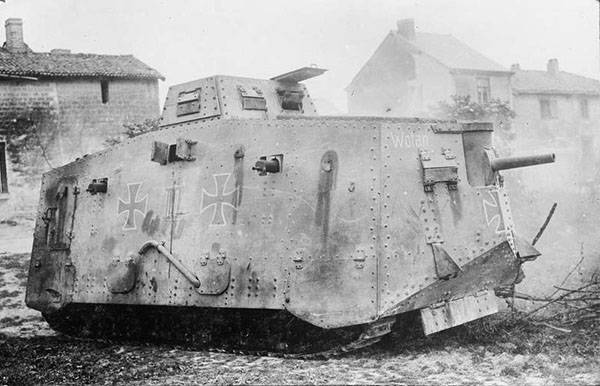
German tank A7V "Wotan" on the Western Front. 1918 year
The forces of the parties
In an effort to achieve a decisive victory over the Entente in 1918 before the arrival of the main forces of the American army, the German High Command concentrated divisions in four army groups for an offensive on the Western Front 194,5. An army group commanded by Crown Prince Rupprecht (4-I, 6-I, 17-I and 2-I armies; the entire 83 division) was located from the coast of the English Channel to St. Quentin. Army group of Crown Prince Wilhelm (18-I, 7-I, 1-I and 3-I army; 61 division) stood from Saint-Quentin to Argonne. 5-I army and army group "C" under the general command of Galvitsa (24 division) was located from Argonne to Moselle. An army group led by the duke Albrecht (19-I army, army groups "A" and "B"; 26,5 divisions) was stationed from Moselle to the border of Switzerland. The total number of German troops on the Western Front was about 4 million. They had more than 15 thousand artillery shells, about 3 thousand aircraft.
Entente troops consisted of 176 infantry and 10 cavalry divisions. From the coast to the area north of Ypres, the Belgian army defended under the command of King Albert, consisting of 12 infantry and 1 cavalry division. Further to Saint-Quentin and to the south were British troops — the 5th, 3rd, 1st and 2nd English armies (60 infantry and 3 cavalry divisions) under the command of Field Marshal Haig. The French troops led by General Petain totaled 104 infantry and 6 cavalry divisions, combined into three army groups. The northern group of armies under the command of Franche d'Esperé in the 4th, 5th and 6th armies (42 infantry divisions) occupied the front from Saint-Quentin to Verdun. The Eastern Army Group, led by General Castelno (consisting of 56 infantry divisions) stood from Verdun to the Swiss border. In addition, 6 infantry and 6 cavalry divisions under the command of General Fayol formed a reserve group, deployed on the roads to Paris in the rear of the Northern, and partially Eastern Army Groups. Allied forces totaled about 5 million people, about 16 thousand guns, over 3800 aircraft and more than 800 tanks.
Thus, the German army surpassed the Allies in the 18,5 infantry divisions, but was inferior to them in total personnel. The army of the Entente had more artillery, aircraft, as well as complete superiority in tanks and cavalry.
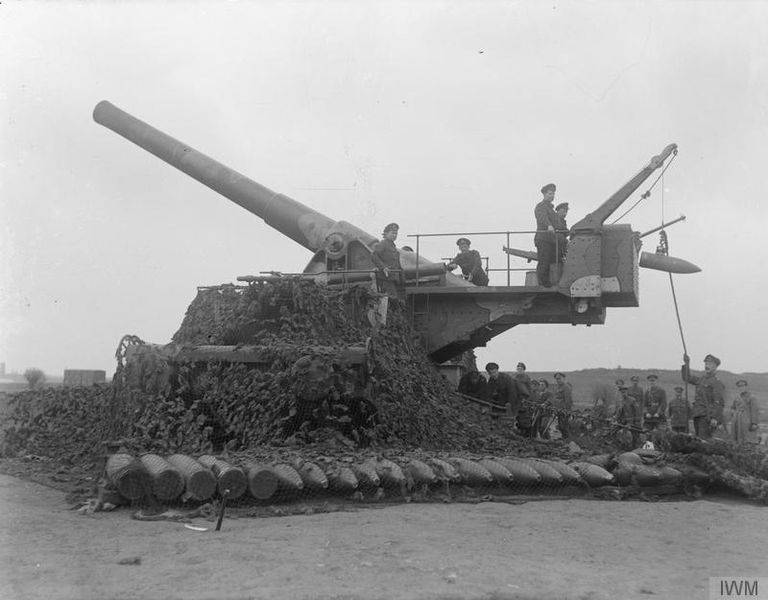
English 9,2 inch rail gun
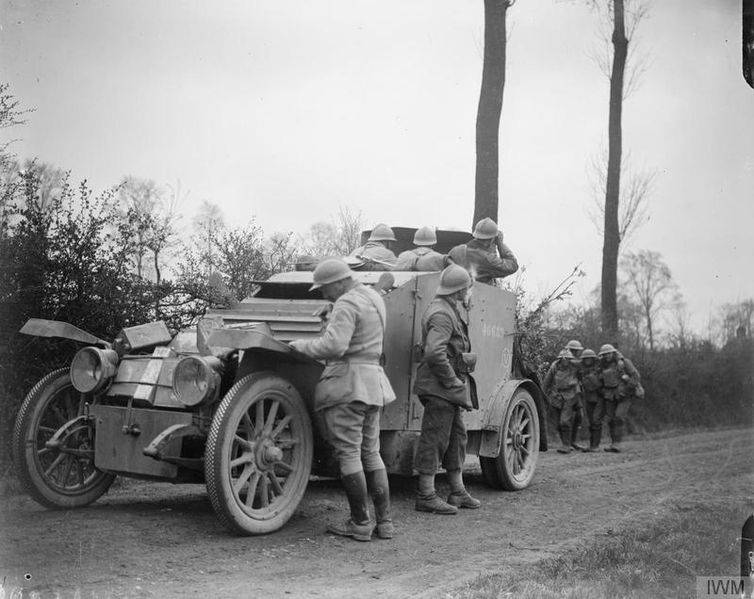
French armored car. April 1918
German offensive plan
The first sketches of a plan for a large spring offensive on the French front were made by the German command as early as the autumn of 1917. 11 November 1917 was held in Mons meeting of the chiefs of staff of army groups. The chief of staff of the Army Group of Crown Prince Wilhelm, Colonel Schulenburg, and the Chief of Operations of the High Command, Lieutenant Colonel Wetzel suggested repeating the strike in the Verdun area. The success of the operation led to the capture of an important fortified area, to strengthen the position of the German army in the central part of the front, as well as to straighten and reduce the front line. However, the French also understood this and, fearing that the enemy would break through to the capital, had large forces and significant reserves in this sector that relied on powerful fortifications. As the 1916 experience showed, the French were ready to fight for Verdun until the last soldier. An offensive in this direction could lead to a new Verdun meat grinder, and finally exhaust the forces and resources of the German army.
The second option was proposed by the Chief of Staff of the Army Group of Crown Prince Rupprecht, General Kul. The plan called for an offensive in Flanders in the area of Armantier and Ypres in order to seize the coast of the English Channel in order to cut off the British army from the French and, pressing the British to the sea, destroy the enemy in a limited space. The plan to defeat the British army was discussed by the German High Command at the end of 1915 - the beginning of 1916. But then this goal was unattainable for the German army. Now the offensive against the British, who suffered significant losses during the 1917 campaign of the year, seemed very promising from a strategic point of view. In case of victory, the possibility of an early end to the war opened up. The Germans could occupy the ports of Calais, Dunkirk and Boulogne, through which they were replenished and various supplies for the Allies. Ports were just 90-100 km from the front line. “If we reach the canal bank,” wrote Hindenburg, “we will directly affect the vital nerve of England. We will not only get the opportunity to interfere with the supply by sea, but from here we will be able to fire the British south coast with our long-range guns. ”
The defeat of the British army and the separation of the forces of the allies, allowed to concentrate all forces against France and withdraw it from the war. The offensive was facilitated by the presence in the rear of the German armies in Flanders a dense network of railways needed to supply the troops. The problem was the fact that the British were also waiting for the enemy attack here and concentrated their main reserves in this area. In addition, as the 1917 battles of the year showed, the main obstacle in this direction was lowland, marshy terrain and adverse weather conditions, which did not allow the offensive to begin earlier than mid-April, when the land more or less dried out. During the 1917 campaign of the year, the advancing British troops literally sank in the mud.
Ludendorff agreed with the idea of Kul that the main blow must be inflicted on the British army. But he considered the most expedient offensive not in the area of Armantier, Ieper, but to the south, in the weakest place of the allied front, between Arras and La Fer, at the junction of the British and French armies. Ludendorff hoped that the German troops, having mastered the line on the Somme Peronn, Am, could, leaning on the left flank on the Somme, move the offensive further in the north-west direction, which led to the curtailment of the English front. At the same time, this led to the disengagement of the British and French armies. Among the advantages of the offensive of the German army was that the start of operations in the area of Arras and La Fera did not depend on weather conditions and was possible in March. In addition, the defense of the British army was organized here much weaker than in Flanders. The second and third positions were not prepared on the whole front. The small reserves of the British command were stationed only in the Cambrai sector. Under Saint-Quentin and to the south they were not at all.
24 January 1918, after Ludendorff’s trip on the front and studying the situation in the 4, 6, 2, 18 and 7 armies, the final decision was made on the 17, 2 and 18 armies between Krauzil and La Fer. The plan of the operation was formulated in the Hindenburg order dated 10 in March 1918. The offensive was appointed in March 21. The main blow should have been inflicted by the 17 and 2 armies of the army group of Crown Prince Rupprecht. Their immediate task was to reach the British in the ledge near Cambrai and to enter the Krausil line, Bapom, the mouth of the river. Ominion; the next is an attack on the front of Arras, Albert. If successful, the 17 Army had to "shake the English front ... before the 6 Army, freeing German forces for mobile warfare, located here." The auxiliary task was assigned to the 18 Army of the Army Group of Crown Prince Wilhelm - to cover the left flank of the strike force. She had to go to r. Somme and the Croz's canal and then force them. Reserve supreme command 3 made infantry divisions. The order provided for the conduct of defensive attacks and artillery shelling of enemy positions in other sectors of the front from 20 to 24 in March. From the organization of distracting operations had to be abandoned due to lack of strength.
A serious shortcoming of the German plan was the lack of development of the offensive after the breakthrough of the enemy defenses. Ludendorff actually refused to plan the operation in depth. He stated: “I object to the term operation. We will break the gap, the rest will be by itself. " Thus, the desire for tactical success and the refusal to plan operations in depth disoriented the troops, contradicted the main goal of Germany - the rapid crushing of the Entente, inevitably led to a depletion struggle, which, like previous campaigns, put the German army in a losing position. In addition, a serious mistake of the German command was that it did not have at its disposal on the Western front significant mobile units necessary for the development of a tactical breakthrough into operational. All the cavalry was left on the Eastern Front (Russia again helped the Western powers). Unable to assess the importance of tanks in Berlin in time. After the massive use of tanks by the Allies in the 1917 campaign of the year, the design of heavy, medium and light tanks began. However, the German industry, in the conditions of a severe shortage of resources, was unable to quickly master the mass production of tanks. By the beginning of the attack, the entire 10 medium tank model A7V had arrived. In addition, 75 trophy tanks were repaired.
It is worth noting that the German command itself was not completely confident in the success of the operation. At the end of January, Kronprinz Rupprecht noted in his diary: "We should not expect too much from the offensive ... I am afraid that its result ... will be expressed only in the bend of the enemy front." Not less doubts were assailed by the chief of staff of the army group of Crown Prince Wilhelm Colonel Schulenburg. On the night of March 21, he told Major L. Beck: “In a battle that starts tomorrow, we can capture 100 000 prisoners and 1000 guns. At the end of the battle, we will find ourselves in an even more difficult situation than before him ... The offensive will not decide the outcome of the war, for this we do not have enough forces. ” Ludendorff also admitted: “What we can achieve is whether we break through the enemy front and develop our attack in the operation or it does not go beyond the limits of the attack, it remained unknown.”
To be continued ...
- Alexander Samsonov
- 1918 Campaign
US world domination strategy
Turkish invasion of Transcaucasia. “Thousands of Russians were shot and burned alive. Armenians are subjected to indescribable torture”
Romanian invasion of Bessarabia
How Romanian executioners exterminated Russian soldiers
German "fist strike" for the purpose of occupation of the western part of Russia
How the Germans occupied the western part of Russia
100 years "lousy" Brest world
100 years of the Baltic Fleet Ice Campaign
Spring Offensive of the German Army
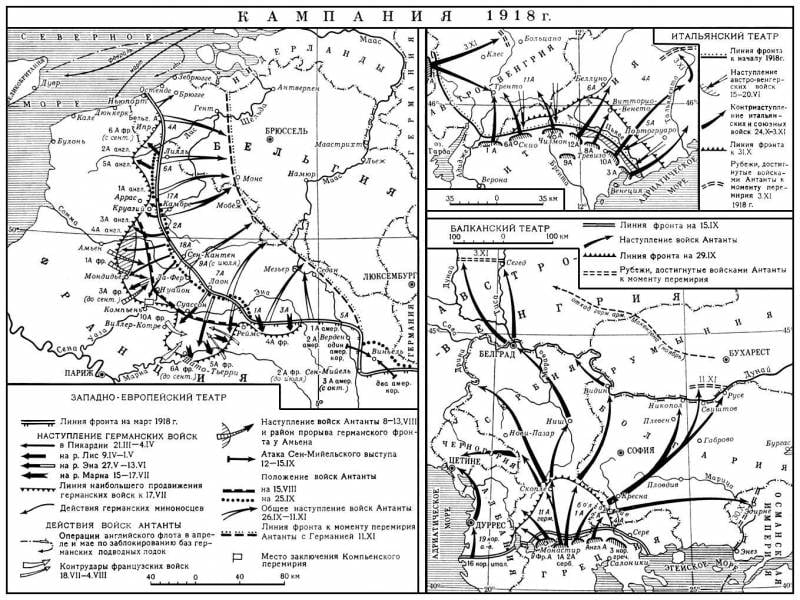
Information